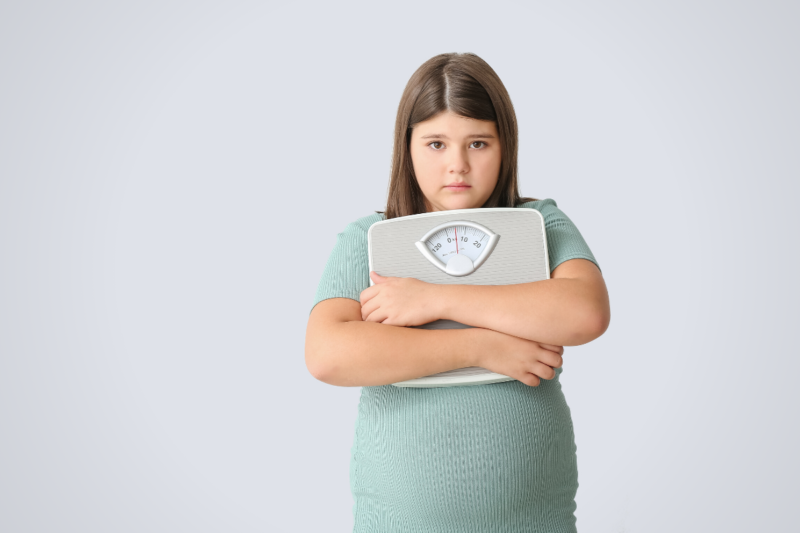
Update: While I stand by this post, I do not currently support Lindo Bacon in light of accounts of a long-term pattern of bad behavior directed towards fat and/or BIPOC individuals that Lindo has not satisfactorily addressed. Basically, their private actions are very different than their public words. Until Lindo takes appropriate accountability for their actions, and makes repairs, I will not give them my support.
One concern about our culture’s preoccupation with weight in general, and some of the anti-fat messages that are coming out of the “war on obesity” specifically, is that they may trigger the development of eating disorders in children, adolescents, teens and adults who are predisposed to them.
An interesting point mentioned in the upcoming book Body Respect by Lindo Bacon, PhD, and Lucy Aphramor, PhD, RD, is that, according to research data, a child is 242 times more likely to have an eating disorder than develop type 2 diabetes. In spite of that, it’s the supposed “epidemic” of type 2 diabetes in kids that garners frequent media attention.
“If it’s about fat, there’s an outcry, but at the expense of other things that are happening,” Aphramor said.
When healthism goes really wrong
In yesterday’s post, I talked about healthism. One outcome of our culture’s pursuit of both health and thinness is that individuals who are thin and who exercise a lot tend to receive a lot of praise and positive feedback, as if those things are inherently healthy. In some cases, they could be signs of an eating disorder, in which case that praise could actually contribute to the continuation of what are in fact unhealthy behaviors.
“It seems like there’s been a shift in how eating disorders manifest now,” Bacon said. “There’s a much higher percentage of people who are using exercise as a form of bulimia.”
Aphramor said that, as with obesity, eating disorders stem in large part from societal issues. “When we are understanding eating disorders, the problem is not that we’ve got a handful of people with body image issues, but we’ve created a society where it’s difficult to be your authentic self,” she said. “We’re taught sort of an aggressive competitiveness that moves us away from valuing diversity as a celebratory thing, and towards judgment and superiority.”
“It’s too easy to ‘locate’ the problem in the individual, but the problem is out there in society,” she said. “It certainly gets played out tragically in people’s lives and people’s bodies, but ultimately we need to tackle gender stereotype, physical and sexual violence.”
The difficult road to HAES
For women and men who have a history of chronic diets or a complicated relationship with food and body weight, it can sometimes be difficult to fully embrace a health at every size (HAES) perspective, especially if they are striving for a body size/shape very different from the one they currently inhabit.
“It’s true, it’s harder to live in this world in a larger body. Size stigma exists,” Bacon said. “We need to help people recognize that they don’t have to change to meet somebody else’s ideal. That’s just painful, but they can move to a place where they feel more embodied and claim their own aesthetic.”
“I think it good, particularly with weight, to recognize the ongoing ambivalence that people experience, that they can get HAES completely intellectually and still want to be thin, and helping them get comfortable with that uncertainty and ambivalence,” Aphramor said. “It’s not that you wake up completely HAES-ified.”
She said it’s important to allow for “the sort of messiness of it” so HAES doesn’t become something else to fail at. “When we allow for real life and the to-ing and fro-ing of it, that’s when it becomes a journey of transformation.”
Embracing the gray areas
Aphramor and Bacon both said that many people decide to go on diets as they are beginning to transition to a HAES mindset, largely because they have some conflicted feelings about giving up old dieting patterns. The difference is that they may have less of a judgmental attitude towards themselves, and to others, then they did before.
Bacon said that this experience can be a valuable learning experience, one that’s more visceral instead of just intellectual, which can ultimately “help them go further in their health at every size journey.”
“I think it can be really helpful for people to hear that narrative,” Aphramor said. “Too often, I think the tendency is to present narratives that are reconciled and neat and have a beginning, middle and end. Life isn’t like that.”
Carrie Dennett, MPH, RDN, is a Pacific Northwest-based registered dietitian nutritionist, journalist, intuitive eating counselor, author, and speaker. Her superpowers include busting nutrition myths and empowering women to feel better in their bodies and make food choices that support pleasure, nutrition and health. This post is for informational purposes only and does not constitute individualized nutrition or medical advice.
Seeking 1-on-1 nutrition counseling? Learn more about her Food & Body, IBS management, and nutrition counseling programs, and book an intro call to see if the program is a good fit, and if we’re a good fit!
Want exclusive content on nutrition, health, diet culture and more, plus critiques of nutrition and health journalism? Subscribe to my Food Noise newsletter! 📣
 Print This Post
Print This Post






